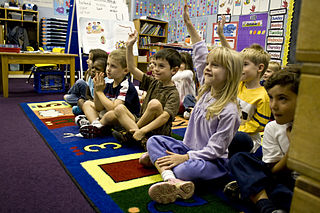
Kindergarten is a preschool educational approach based on playing, singing, practical activities such as drawing, and social interaction as part of the transition from home to school. Such institutions were originally made in the late 18th century in Germany, Bavaria and Alsace to serve children whose parents both worked outside home. The term was coined by German pedagogue Friedrich Fröbel, whose approach globally influenced early-years education. Today, the term is used in many countries to describe a variety of educational institutions and learning spaces for children ranging from two to six years of age, based on a variety of teaching methods.

Head Start is a program of the United States Department of Health and Human Services that provides comprehensive early childhood education, health, nutrition, and parent involvement services to low-income children and families. The program's services and resources are designed to foster stable family relationships, enhance children's physical and emotional well-being, and establish an environment to develop strong cognitive skills. The transition from preschool to elementary school imposes diverse developmental challenges that include requiring the children to engage successfully with their peers outside the family network, adjust to the space of a classroom, and meet the expectations the school setting provides.

Child care, otherwise known as day care, is the care and supervision of a child or multiple children at a time, whose ages range from two weeks of age to 18 years. Although most parents spend a significant amount of time caring for their child(ren), child care typically refers to the care provided by caregivers that are not the child's parents. Child care is a broad topic that covers a wide spectrum of professionals, institutions, contexts, activities, and social and cultural conventions. Early child care is an equally important and often overlooked component of child's developments.

A preschool, also known as nursery school, pre-primary school, play school or creche, is an educational establishment or learning space offering early childhood education to children before they begin compulsory education at primary school. It may be publicly or privately operated, and may be subsidized from public funds.

Early childhood education (ECE), also known as nursery education, is a branch of education theory that relates to the teaching of children from birth up to the age of eight. Traditionally, this is up to the equivalent of third grade. ECE is described as an important period in child development.
The Early Childhood Education Act is the name of various landmark laws passed by the United States Congress outlining federal programs and funding for childhood education from pre-school through kindergarten. The first such act was introduced in the United States House of Representatives by Congresswoman Patsy Mink of Hawaiʻi in the 1960s. The theory behind the act is that the years before a child reaches kindergarten are the most critical to influence learning. Many children do not have access to early education before entering kindergarten. The goal of the act is to provide a comprehensive set of services for children from birth until they enter kindergarten.

Primary education in the United States refers to the first seven to nine years of formal education in most jurisdictions, often in elementary schools, including middle schools. Preschool programs, which are less formal and usually not mandated by law, are generally not considered part of primary education. The first year of primary education is commonly referred to as kindergarten and begins at or around age 5 or 6. Subsequent years are usually numbered being referred to as first grade, second grade, and so forth. Elementary schools normally continue through sixth grade, which the students normally complete when they are age 11 or 12. Some elementary schools graduate after the 4th or 5th grade and transition students into a middle school.
A preschool teacher is a person who is employed to care for children from infant to 4 years of age in a daytime setting. “Preschool“ is the category for children aged 2 to 4 years of age..
Universal preschool is an international movement supporting the use of public funding to provide preschool education to all families. This movement is focused on promoting a global, rather than local, preschool program. The goal is to provide equity across all socioeconomic backgrounds, enabling children to improve their academic and social skills before they attend kindergarten. Universal preschool, funded by the public, would allow more families to send their children to preschool.
Educational inequality is the unequal distribution of academic resources, including but not limited to school funding, qualified and experienced teachers, books, and technologies, to socially excluded communities. These communities tend to be historically disadvantaged and oppressed. Individuals belonging to these marginalized groups are often denied access to schools with adequate resources. Inequality leads to major differences in the educational success or efficiency of these individuals and ultimately suppresses social and economic mobility. Inequality in education is broken down into different types: regional inequality, inequality by sex, inequality by social stratification, inequality by parental income, inequality by parent occupation, and many more.
Susan Neuman is an educator, researcher, and education policy-maker in early childhood and literacy development. In 2013, she became Professor of Early Childhood and Literacy Education, and Chair of the Department of Teaching and Learning at NYU's Steinhardt School of Culture, Education, and Human Development.
Bright from the Start, also known as Georgia Department of Early Care and Learning, was established on July 1, 2004. The main office is located in downtown Atlanta, Georgia. The department licenses and monitors daycare centers and all state funded pre-k. Bright from the Start is headed by one commissioner and by a board of administrators. Bright from the Start provides children with quality preschool knowledge that will be necessary for their future school achievements. They want to offer a system of professional development for the providers and for the staff.

Samuel J. Meisels is an American academic in the areas of early childhood assessment, child development and educational practices that support the developmental needs of young children.
Adam Winsler is a developmental psychologist known for his research on early child development, private speech, and benefits of arts education. Winsler is Professor of Applied Developmental Psychology at George Mason University.
Margaret R. Burchinal is a quantitative psychologist and statistician known for her research on child care. She is senior research scientist and director of the Data Management and Analysis Center of the Frank Porter Graham Child Development Institute of the University of North Carolina at Chapel Hill.
A preschool, also known as kindergarten or child care centres in Singapore, is an educational establishment or learning space offering early childhood education to children before they begin compulsory education at primary school. All Singapore Citizens born after 1 January 1996 and living in Singapore must attend a national primary school unless an exemption is granted.

The Early Childhood Development Agency is an autonomous government agency of the Ministry of Social and Family Development (MSF) that manages the early childhood education sector such as overseeing the development of childcare centres and kindergartens in Singapore. The agency is jointly overseen by the Ministry of Social and Family Development (MSF) and Ministry of Education (MOE).
Early childhood education in the United States relates to the teaching of children from birth up to the age of eight. The education services are delivered via preschools and kindergartens.
Cassandra Cybele Raver is an American developmental psychologist currently serving as Provost and Vice Chancellor for Academic Affairs at Vanderbilt University. She previously served as Deputy Provost at New York University and Professor of Applied Psychology in the Steinhardt School of Culture, Education, and Human Development at NYU.
Primary responsibility for early learning, preschool and child care in Canada rests with the 13 provincial and territorial governments. Since 1984, there have been a number of unsuccessful attempts at establishing a national child care system. By 2019 in Canada, about 60% of children who were 0 to 5 years-old participated in day care arrangements. Of these, 52% were in formal day care settings and 26% were cared for by a relative in an informal setting. About 40% of parents had difficulty finding child care arrangements. As of 2016, 30% of child care operations in Canada were for-profit, which includes large single-owner corporate chains. Some federal, provincial, territorial, and municipal public funding of child care is limited to not-for-profit child care operations.








